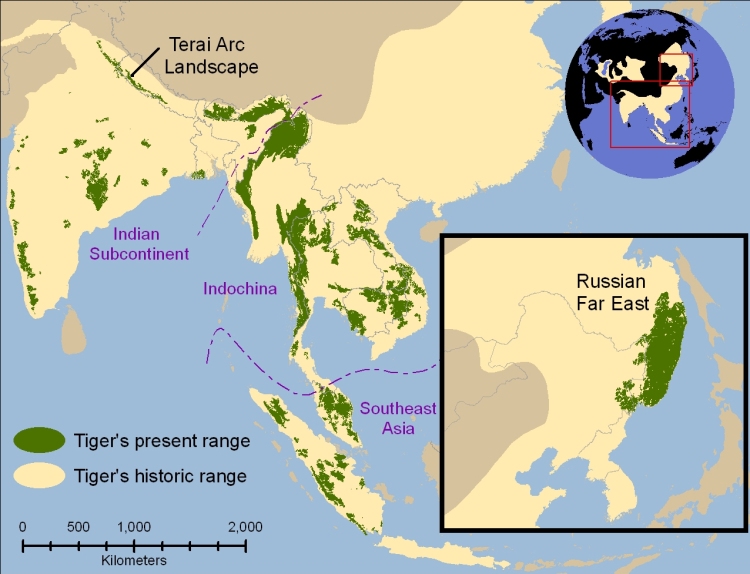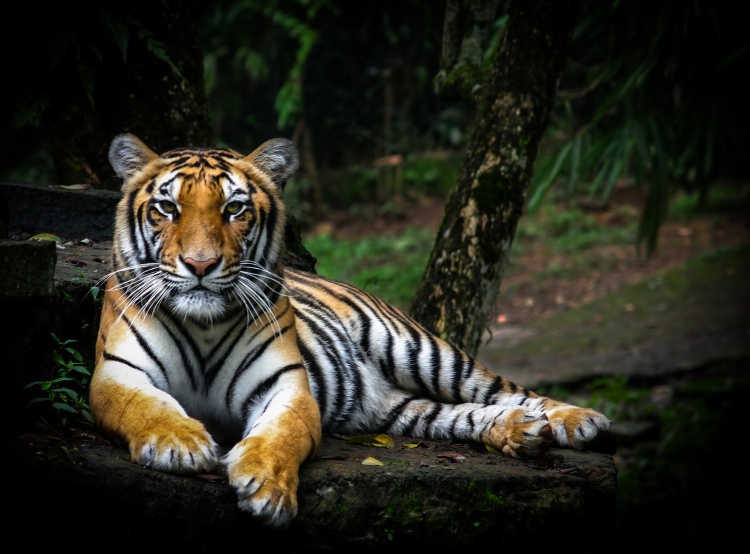
While all wild felids are extraordinary creatures, there is one that stands above them all (literally). It is beautiful and terrifying, powerful and threatened: the tiger (Panthera tigris). This post is an introduction to this most majestic of cats.
Subspecies
There are five surviving subspecies of Panthera tigris (Hunter, 2015; Macdonald, Loveridge, & Nowell, 2010). They are:
- Panthera tigris altaica: The Amur tiger of eastern Russia.
- P. t. tigris: The Royal Bengal tiger of the Indian subcontinent.
- P. t. corbetti: The Indochinese tiger of Indochina.
- P. t. sumatrae: The Sumatran tiger of Sumatra.
- P. t. jacksoni: The Malayan tiger of the Malayan Peninsula (Goodrich et al., 2015). There is some debate about whether this subspecies is genetically “real” (Hunter, 2015).

Size
Tigers can weigh between 75-260 kg (165-570 lbs) (Panthera, 2015d), making them the world’s largest cat. However, their size varies considerably by sex and across their range (Hunter, 2015; Macdonald et al., 2010). The heaviest wild tiger ever recorded was a Bengal tiger that weighed 261 kg (575 lbs), whereas Sumatran tigers only reach 140 kg (308 lbs) (Hunter, 2015).
Diet
Since tigers are tigers, they are capable of taking down nearly any animal they encounter. In Russia this even includes brown bears (Hunter, 2015; Miller et al., 2013). Only adult Asian elephants and rhinos are safe from this mighty cat (Hunter, 2015).
Range
The tiger’s range collapse is almost unbelievable. At one point, their territory stretched from Turkey to the Russian far east (Goodrich et al., 2015; Macdonald et al., 2010; Hunter, 2015). Tigers are now restricted to just 4% of their former range (Panthera, 2015d).
There are known breeding populations of Panthera tigris in India, Bangladesh, Indonesia, Russia, Bhutan, Malaysia, Nepal, and Thailand. There may also be tigers in Myanmar, China, and North Korea (Goodrich et al., 2015).

Conservation Status
Tigers are the most threatened of all big cats (Hunter, 2015). There may now be as few as few as 3,200 tigers left in the wild (Panthera, 2015d), with 70% of them occurring in less than 0.5% of their historic range. As such, they are listed as endangered throughout the world; with Malayan and Sumatran tigers being classified as critically endangered (Hunter, 2015).
Threats
The greatest threat to wild tigers is poaching for the Traditional Asian Medicine (TAM) trade. Tiger body parts are believed to have special properties: curing everything from inflammation (Goodrich et al., 2015) to epilepsy (Panthera, 2015d). This illegal trade has proven hard to reduce, despite the fact that the World Federation of Chinese Medicine Societies (WCMS) has stated that tiger parts are not required for personal health (Loveridge, Wang, Frank, & Seidensticker, 2010).
Besides poaching, the other major threats to tigers are habitat loss and fragmentation, prey depletion, and human-tiger conflict (HTC) (Goodrich et al., 2015; Panthera, 2015d). The latter can take the form of attacks on people, which is a serious problem in some areas (Barlow, Ahmad, & Smith, 2013).

Conservation Strategies
Effectively protecting known breeding populations of tigers is the most urgent conservation priority (Panthera 2015c; Walston et al., 2010). This will involve curtailing poaching through increased law enforcement (Panthera, 2015d), reducing the demand for tiger parts, lessening the severity of HTC, and preventing the overhunting of prey (Goodrich et al., 2015).
But this alone will not be enough. It is also necessary to make sure existing protected areas are connected through biological corridors that allow tigers to move throughout the landscape (Harihar & Pandav, 2012; Wikramanayake et al., 2011; Yumnam et al., 2014).
Conclusion
Panthera tigris’ situation is grim, but it is not hopeless. If enough of us unite to protect this most charismatic of species, we can reverse their decline. By raising awareness about their plight, talking about how awesome they are, donating to worthy NGOs, and making it socially unacceptable to trade in tiger parts; we can ensure that future generations will be able to share the world with this most magnificent of cats.
Further Reading:
Goodrich, J., Lynam, A., Miquelle, D., Wibisono, H., Kawanishi, K., Pattanavibool, A., … Karanth, U. (2015). Panthera tigris. The IUCN Red List of Threatened Species 2015: e.T15955A50659951. Retrieved from http://www.iucnredlist.org/details/full/15955/0.
Hunter, L. (2015). Wild cats of the world. New York, NY: Bloomsbury Publishing Plc.
Macdonald, D. W. & Loveridge, A. J. (2010). Biology and conservation of wild felids. New York, NY: Oxford University Press.
Panthera. (2015d). Tiger. Retrieved from https://www.panthera.org/cat/tiger.
I have learned. Highly informative. Preserving these animals needs our collective efforts.
LikeLiked by 1 person
Thank you Paul! Yes, it’s going to take all of us to preserve animals like tigers. But this is such an important species, and the world is coming together to protect them like never before.
LikeLiked by 1 person
You are welcome, Josh. There’s hope then.
LikeLiked by 1 person
This is a very educative post, and interesting as well.
LikeLiked by 1 person
Thank you! I was trying to be educational without being boring.
LikeLiked by 1 person
You managed to do exactly that. :)
LikeLiked by 1 person
I agree with Niyati. It wasn’t boring at all. And that pic, in the centre. It instill a sense of awe and immense respect. The tiger is so majestic. This post is not boring at all. In fact quite the opposite, it gives all the important numbers in a very easy-to-read and understand manner.
LikeLiked by 2 people
Oh thank you! It’s really hard to look at a good picture of a tiger and not feel awe and respect for them. They just seem to command our attention…I think it might actually be embedded in our DNA.
LikeLiked by 1 person
Exactly, the pictures even were fetching!
LikeLiked by 2 people
I rather like them too :)
LikeLiked by 1 person
Thanks for the post, Josh! :) This was so very informative. Loved reading this. I especially liked the heading and images.
LikeLiked by 1 person
Thank you for the compliments!
LikeLiked by 1 person
A beautiful animal. Very informative post.
LikeLiked by 1 person
Thank you Ellen! I think they’re beautiful too :)
LikeLiked by 1 person
The world just doesn’t seem to understand what a devestating loss it would be if we lost one more species
LikeLiked by 1 person
No, but people are starting to realize that ecosystems are extraordinarily interconnected. The loss of one species, especially large carnivores, can have ripple effects that influence all others: including humans. As this inter-connectivity becomes more widely appreciated, hopefully more people will realize why it’s so important to minimize the loss of biodiversity.
LikeLiked by 1 person
I won’t pretend I knew everything but as just a person who cares, I understand how one species reacts and relies on another and so on. So should everyone else.
LikeLiked by 1 person
Excellent article as usual. I wish the traditional medicine would stop using them. They’re so gorgeous!
How long does it take you to do the research for each of these?
LikeLiked by 1 person
Yes, what we really need is for influential traditional medicine practitioners to speak out against using tiger parts. They can’t just say it’s not necessary; they need to say it’s morally wrong.
How long it takes me to do the research varies by topic. For some posts I can use materials that I’ve already read. But for this post everything was new. I’d say it took me about two weeks to read everything…or maybe a little less.
LikeLike
That would be a step in the right direction for sure. That’s a lot of research! Thanks for doing it and summarizing it for me. :)
LikeLiked by 1 person
No problem!
LikeLike
Wonderful Tiger.!
LikeLiked by 1 person
Yes it is! Thank you for stopping by :)
LikeLiked by 1 person
You’re welcome Josh.!
LikeLiked by 1 person
Good post. I’m curious, why did you leave out the South China tiger subspecies? Is it because it’s extinct from the wild? I would also recommend fact-checking your information on tiger weights since Amur tigers can weigh 600-700 lbs. You were able to deliver a lot of information in one post. I particularly like the map you used.
LikeLiked by 1 person
Yes, I left out the South China subspecies because everything I read indicated it’s extinct in the wild. In hindsight I probably should’ve talked about it, but at the time I didn’t think it was necessary.
You also make a good point about the weights. I looked back at the source I used for my figures (Wild Cats of the World by Luke Hunter) and it does say in parentheses that captive tigers have been measured at 325kg (716 lbs). The numbers I used are for the largest WILD tiger ever recorded, so I’ll change my post to reflect that. Thanks for the heads up!
LikeLiked by 1 person
*Edit: Wild Cats of the World said CAPTIVE tigers have been measured up to 325kgs. I accidentally typed wild, but have since corrected my reply.
To be extra clear: captive tigers (it does not say which subspecies, but I’m sure you’re right) have been recorded at 325kgs. The largest known wild tiger weighed 261kg.
LikeLike
Nice. Very new genre for me. But enjoyed nonetheless. :)
LikeLiked by 1 person
Thank you! I admire your willingness to step into a new genre, especially since this genre deals with big cats :)
LikeLiked by 1 person
Yes. The writing and the picture helped. Well constructed post :)
LikeLiked by 1 person
A wonderful post Josh. Thank you for educating us on a very important & interesting topic like this. These magnificent creatures need to be living in all the grandeur and freedom they deserve :) And its good to hear that awareness is rising day by day :)
LikeLiked by 1 person
Thank you Mithai! You’re right about the fact that awareness of the plight and importance of tigers is steadily increasing. They’re still incredibly threatened, but more and more people are fighting for their survival.
LikeLiked by 1 person
I hope the cruelty against them stops soon :) Its really sad how low people can go for their greed.
LikeLiked by 1 person
Thanks for sharing!
LikeLike